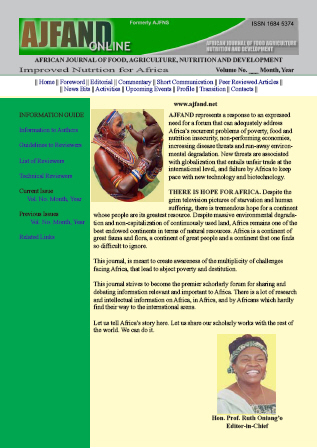
|
African Journal of Food, Agriculture, Nutrition and Development
Rural Outreach Program
ISSN: 1684-5358
EISSN: 1684-5358
Vol. 13, No. 4, 2013, pp. 7957-7971
|
 Bioline Code: nd13060
Bioline Code: nd13060
Full paper language: English
Document type: Research Article
Document available free of charge
|
|
|
African Journal of Food, Agriculture, Nutrition and Development, Vol. 13, No. 4, 2013, pp. 7957-7971
| en |
GROWTH PERFORMANCE AND BIO-ECONOMICS OF GROWING PIGS FED DIETS CONTAINING SEPARATELY FERMENTED AND UNFERMENTED CASSAVA TUBER WASTES
Aro, SO; Agbede, JO; Aletor, VA & Ashimi, AA
Abstract
A feeding trial was conducted to investigate the performance, haematology, nutrient digestibility and economics of production of growing pigs fed diets containing differently fermented cassava starch residue (CSR) and cassava peels (CP) altogether referred to as cassava tuber wastes (CTW). The CSR and CP were each divided into three parts and processed as dry unfermented (UFCRS Diet 2; UFCP Diet 5), naturally fermented (NFCSR Diet 3; NFCP Diet 6) and microbial fermentation by inoculation (MFCSR Diet 4; MFCP Diet 7). Each part was included in a control diet (Diet 1) to replace maize at 20% dietary level to make a total of seven treatments. The final live weight (FLW), total live weight gain (TLG) and total feed consumption (TFC) of pigs fed the control diet were not significantly (p>0.05) different from those fed the test diets. However, the feed conversion ratio (FCR) of pigs fed the control was consistently lower (3.93) than those fed CSR (3.68-3.30) and CP (3.75-3.36)-based diets. The response of RBC, WBC, Hb and PCV to the dietary treatment varied significantly (p<0.05) with the CTW-product incorporated into the diets vizs: RBC 106/mm3: 7.53 vs CSR (5.71-6.26) and CP (4.71-5.75); WBC 103/mm3:14.84 vs CSR (9.06-10.06) and CP (8.53-10.90), and PCV%: 36.75 vs CSR (35.75-36.00) and CP (32.5-37.00) while the MCHC and differential counts were not significantly (P>0.05) affected. Varied effects on the digestibility of major ingredients in the diets were observed with the digestibility of dry matter (DM) been enhanced: 0.49-8.68% and 3.10-7.48%, organic matter (OM): 1.60-9.37% and 3.41-8.43%, crude protein: 3.33-6.17% and 1.18-4.10%, and crude fibre (CF): 24.37-30.52% and 2.34-28.80% by CSR and CP, respectively, over the control diet. The Mean Apparent Digestibility (MAD) for NFE (CSR 65.07%; CP 69.33%) was higher than that of the control diet (61.49%). The cost of feed intake per pig decreased: 11.92-12.76% and 8.38-14.95%, cost of feed per kg body weight gain: 14.84-22.66% and 14.84-21.88% with enhanced gross profit increase of 19.66-29.02% and 14.37-26.50% in CSR- and CP-based diets, respectively. It can, therefore, be concluded that CTW products could be included in pig’s diet as an alternative to maize.
Keywords
Bio-economics; cassava; wastes; performance; pigs
|
| |
© African Journal of Food, Agriculture, Nutrition and Development
Alternative site location: http://www.ajfand.net/
|
|
